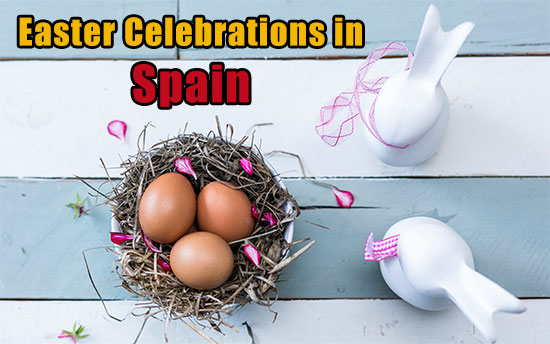Easter Celebration in Spain
Easter in Spain, or "Semana Santa," is one of the most important religious festivals in the country. It is celebrated with great fervor and passion, particularly in Andalusia, where elaborate processions and ceremonies take place. The processions, known as "pasos," feature ornate floats, or "tronos," that depict scenes from the Passion of Christ. They are carried through the streets by members of religious brotherhoods, or "hermandades," who wear traditional robes and hoods. The atmosphere is somber and solemn, with mournful music and the sound of bells accompanying the processions. The week culminates on Easter Sunday, when the mood lifts and people celebrate the resurrection of Christ with feasting and merrymaking.

The Spanish call it Semana Santa.
Easter is considered one of the most important festival in Span, and it is marked with Parades, decorations, feasts and gifts. Spain has a rich legacy of heritage and culture, and it is well depicted in their Easter parades. Easter is a week long celebration in Spain, celebrated across the length and breadth of the country. People are seen to be carrying leafy palm or olive branches, large in size, as a mark of the celebration.

People generally wear the Nazareno, the penitential robe in the processions, the parade of Zamora being an exception. This dress comprises a hood/cap with a conical tip, which can be used to cover the face of the person who wears it. It also has a tunic, and sometimes a cloak as well. This was the dress code for medieval time penitents, who could show their penance, even while keeping their faces covered. The people wearing this can carry wooden crosses, candles, and may even walk barefoot and wear shackles or chains on their feet.
Places of interest in the Easter period:
Seville has one of the grandest Easter parades. The custom is centuries old. The parade is known as Semana Santa de Sevilla. They feature Pasos, which are lifelike wooden sculptures, painted, and depicting the different moments of the life of Jesus Christ. Quite a few of these sculptures would carry great antique value as well, being done by masters of art.
Valladolid is considered as a Fiesta of International Tourist Interest of Spain since 1981, and for good reasons. The glory of Castilian religious sculpture is in full display at the good Friday parade. Poetic proclamations are made by members of brotherhood on horsebacks, throughout the day. Plaza Mayor Square sees the recital of Sermon of the Seven Words. The passion parade, hosted in the afternoon, comprises 31 religious statues or pasos carved in the 16th and 17th centuries by various famous artists, is participated by thousands of people. The most emotional and high point of the procession is the return of the last statue to the church, the Virgen de las Angustias, on whose honour the Salve Popular is sung.
Salamanca also prides itself on hosting one of the oldest Easter celebrations in the country. The traditions are continuing since the year 1240 ! The city itself on UNESCO world heritage site, and provides for the best background to the parades. The artworks (images and pasos) are created by Spanish masters of art like Luis Salvador Carmona or Mariano Benlliure. The processions are also associated with the University of Salamanca, the oldest institution of this nature in Spain. All these makes the celebrations unique and beautiful in Salamanca.
The oldest Easter celebrations in Spian is credit to the ones in Zamora. Penance parades for Easter can be traced to as early as 1179 ! The Holy Easter week observance is taken care of by 16 fraternities and sisterhoods, who perform 17 penance parades in Zamora streets. The parades are attended by thousands comprising locals as well as tourists. More than 300,000 people are in Zamora at the holy week, which is over 5 times its inherent population.
Zamora has the oldest celebrations in Spain. The earliest penance processions can be traced back to 1179. Holy Week in Zamora is celebrated by 16 sisterhoods and fraternities that perform 17 penance processions on the streets of the old city. Thousands of penitents walk the streets while the processions are attended by a crowd of locals and visitors. Zamora increases its population 5 times, up to 300.000 people during the festival. Effort is given to bring back the medieval ambience, and the brotherhoods use monk robes instead of the popular Nazareno hats. Candles are shunned in favour of torch fires, and male choirs are preferred instead of bands.
León is also a famous place when it comes to Easter celebration in Spain, with more than 15,000 penitents hitting the streets in Easter parades. Parades commence on Viernes de Dolores" (the Friday in the week before Holy Week) are taken out every day until Easter Sunday. The procession of the meeting, is the most famous parades of this time, which is also known as Procesion de los Pasos", also known as the "Procesion del Encuentro". It is a long, 9 hour procession, where about 4,000 penitents carry 13 pasos (statues) in the streets of León. The most emotional point of the procession is El Encuentro (The Meeting). It is when the idol representing St. John and the idol representing La Dolorosa face each other and the penitents move in a fashion such that the two figurines are in a dancing trance. Semana Santa in Leon has become a Fiesta of International Tourist Interest of Spain since 2002.
Granada and Málaga are two more places of Spain where Easter processions are taken out and feature in prominent lists of tourist attractions. The celebrations at Málaga are different from rest of the country as they accompany high voltage happiness, spontaneous saetas (flamenco verses sung at the processions), fun, frolic and applause as the figurines, carvings or paintings pass by.
Holy Week SEVILLE, Easter SPAIN [SEMANA SANTA]

 Friendship Day
Friendship Day Good Morning
Good Morning